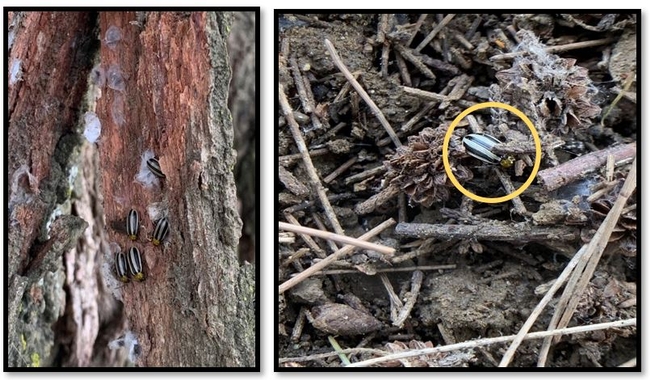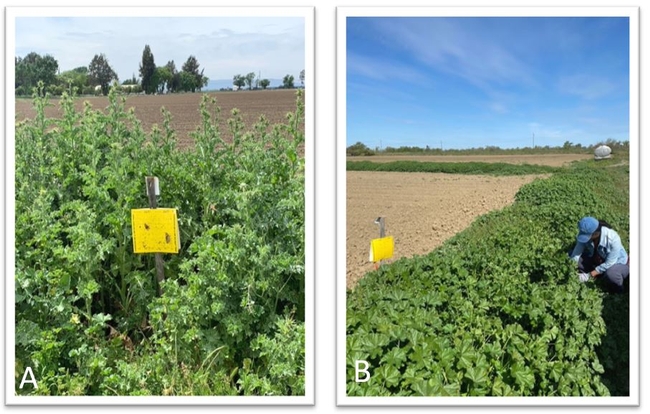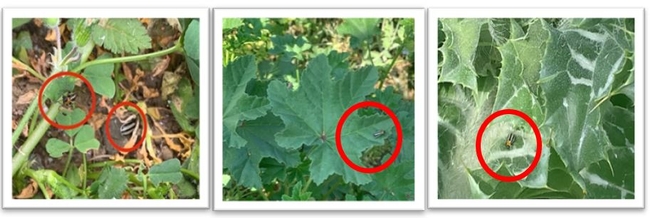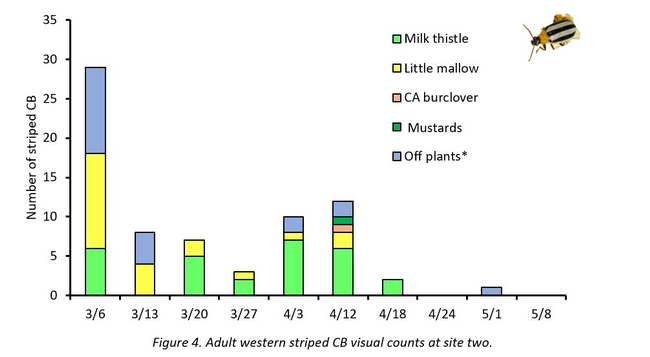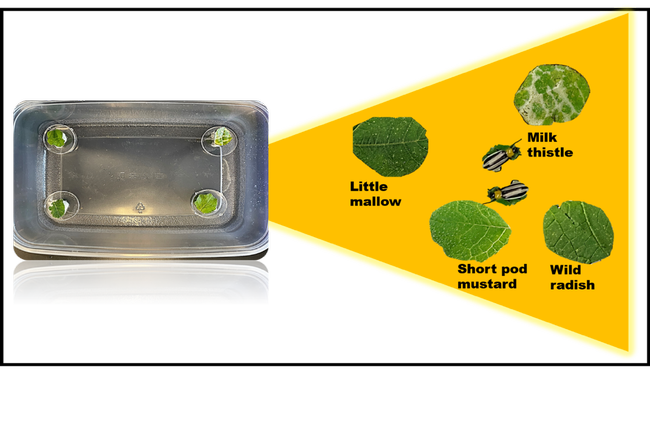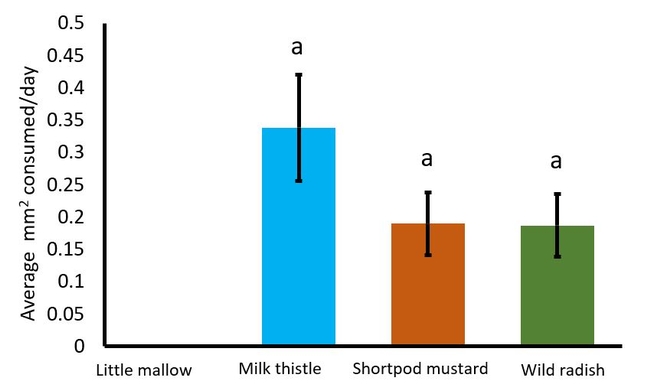-Jasmin Ramirez Bonilla, Masters student in Grettenberger lab, Department of Entomology and Nematology, UC Davis
-Ian Grettenberger, UCCE Field and Vegetable Crops Entomology Specialist, Department of Entomology and Nematology, UC Davis
-Amber Vinchesi-Vahl, UCCE Vegetable Crops Advisor, Colusa, Sutter and Yuba counties
The relationship between weeds, crops and insects is important for pest management. Knowledge of this relationship for specific insect pests can increase efficacy of IPM practices like crop rotation and weed management. Insects can rely on weeds for resources such as food and shelter. Weeds that are closely related to the host crop are particularly important in certain systems. For example, nightshades are related to tomato plants and can provide additional resources for pest insects of tomato, and harbor plant diseases like tomato spotted wilt virus. Weeds can also be reservoirs for plant diseases as well as harbor beneficial insects.
In the case of fresh-market muskmelons in the Sacramento Valley, we wondered what the role of weeds and surrounding field vegetation was in sheltering the western striped cucumber beetle.. Western striped cucumber beetles are a major pest of melons and cucurbits and are host-specific; they will only reproduce on cucurbits. They overwinter as adults and become active in late winter, but cucurbits are not planted until spring. Because of this gap in host availability, we conducted a study to characterize the non-crop habitat for the western striped cucumber beetle. This study was conducted by Jasmin Ramirez Bonilla, a Masters student in the Grettenberger lab in the Department of Entomology and Nematology at UC Davis.
In the fall, these beetles leave melon fields after all vegetation has been removed and aggregate under protective structures such as tree bark and dead foliage during the cold and rainy days of the year (Fig 1). Once the weather warms up in February/March of the following year, the beetles emerge from their overwintering locations and can be found on wild weeds adjacent to agricultural fields.
Figure 1. Adult western striped CB overwintering underneath tree bark and wood debris.
We conducted a study to characterize the non-crop habitat and observe the feeding behavior of the western striped CB during the non-cucurbit season. While we know that the western striped CB feeds exclusively on cucurbits throughout the crop season, we have learned it feeds on other plants during late winter/spring. Because of the timing of melon planting in the Sacramento Valley (May-July), the beetles require nourishment before their preferred host is available and must feed on something to survive. Technically, they could survive (and reproduce) on wild cucurbits, but these are not widespread in field margins in the Sacramento Valley, so they instead feed on weeds along field edges.
In March 2020, we conducted an observational field study to characterize the non-crop habitat of the western striped CB. We deployed yellow-sticky cards on wooden stakes in weedy areas at two empty organic fields previously planted with cucurbits (Fig 2a). We identified weed species within 20 ft. to the right and left of each trap. We conducted four-minute visual counts around each trap and recorded the number of beetles observed on various weed species to better understand the relationship between weed species and beetle abundance per trap (Fig 2b). In addition, we measured weed abundance using percent cover assessments to associate weed species with beetle abundance from the visual counts.
Figure 2. A) Yellow-sticky trap in unmanaged weeds at barren fields (previously cucurbits). B) Four-minute-counts in randomly selected plants adjacent to the traps.
Figure 3. Adult western striped CB images inhabiting wild weeds in the early spring.
From these studies, we learned that the western striped CB was associated with broadleaf weeds, specifically milk thistle, little mallow, white clover, and some mustard species on field edges (Fig 3). We observed most beetles on milk thistle and little mallow (Fig 4). According to the percent cover assessment, milk thistle accounted for 17-19% of vegetative cover. As for little mallow, percent cover ranged from 8-27.4% between sites. Wall barley was abundant across both sites (>20% ercent cover). However, there were no beetle sightings on this grass (Table 1).
Figure 4. Adult western striped CB visual counts at site two.
|
|
Site 1 |
Site 2 |
|
Common name of weeds found in surveys |
% Cover |
% Cover |
|
Wall barley (grass) |
20 |
28 |
|
Milk thistle (broadleaf) |
19 |
17 |
|
Little mallow (broadleaf) |
27.4 |
8 |
|
Brassicas (broadleaf) |
5 |
4.2 |
|
CA burclover (broadleaf) |
0.2 |
4.6 |
|
Bare ground + leaf litter |
12 |
18.1 |
Table 1. Percent weed cover for different weed species observed in non-crop survey at site one and two.
Despite these results, we were not confident that the western striped CB truly preferred these weeds. The beetles might have been inhabiting these weeds because they were preferred food sources or simply because they were abundant at each site and offered a place for beetles to rest. Even if the beetles did not actively feed on these species, they could still serve as habitat.
In 2021, we assessed the feeding preference of western striped cucumber beetles for four weed species in laboratory bioassays to test the association between broadleaf weeds and beetles that we observed in the 2020 field study. We evaluated the following weed species: milk thistle, little mallow, wild radish, and shortpod mustard. We selected these species based on previous research and our findings from the field surveys. We used multiple-choice tests, where insects are given two or more feeding choices, to determine whether the western striped CB strongly prefers a specific weed. We recorded the feeding damage by adult cucumber beetles on leaf circles (3-cm diameter) inside plastic containers for ten days (Fig 5).
Figure 5. Schematic design of choice assay chamber with leaf discs, and inset image of each weed species with names and adult striped CB.
Feeding preference by the western striped CB varied across weed species. Milk thistle was the most consumed species, although the feeding level was not significantly different compared to either wild radish or shortpod mustard. We likely saw no significant differences between shortpod mustard and wild radish because both species belong to the same family. No beetles fed on little mallow; these leaf discs were untouched (Fig 6).
Figure 6. Feeding averages (±SE) for each wild weed species. Letters indicate lack of significant differences in between treatments. Note that little mallow was not fed on at all.
The results from the choice bioassay confirmed our speculation about western striped CB preference for specific weeds. Nonetheless, the results with little mallow were surprising since we observed them on little mallow in the 2020 field studies. These outcomes help clarify the association between beetles and weed species. It is likely not driven by only weed abundance but also by preference for specific food sources. These results, coupled with those from our 2020 observational study, indicate that the western striped CB prefers feeding on broadleaf weeds (preferably milk thistle) to survive the non-cucurbit season.
The outcomes from these studies can inform IPM decisions for western striped CB. For example, our results could help address the specifics of "where" to scout and monitor for these beetles before they move into cucurbit and melon fields. Pest control advisers or growers could scout semi-natural areas surrounding fields, where milk thistle and/or mustards are abundant, and estimate western striped CB population density before planting. Depending on how important of a host milk thistle is, it could be a target for weed management. We still have a lot to learn about how this pest uses weedy, non-crop areas to survive when cucurbits are not present, but identifying potential hosts is a crucial first step.
